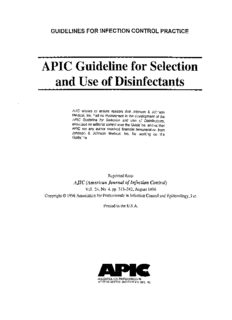
APIC Guideline for Selection and Use of Disinfectants PDF
Preview APIC Guideline for Selection and Use of Disinfectants
AJIC 314 APIC Guideline August 1996 this guideline, entitled “Guideline for Handwash- BACTERIALSPORES ing and Hospital Environmental Control, 1985,” Bacillus subtilis was published in .November 1985.2 This latter 4 guideline did not recommend chemical germi- MYCOBACTERIA cides that were formulated for use on medical Mycobacterium tuberculosis equipment or environmental surfaces in health a care facilities. Rather, the revised CDC guideline NONLIPID OR SMALLVIRUSES focused on strategies for disinfection and steril- ization of medical (equipment used in the health polio virus care setting. 4 The purpose of this revised Association for FUNGI Professionals in Infection Control and Epidemi- Trichophyton spp. ology, Inc. (APIC) Guideline, which is an updated version of previous publications,3-6 is to assist VEGETATIVE BACTERIA health care professi~onals in their decisions involv- ing the judicious selection and proper use of Pseudomonas aeruginosa specific disinfectants. In the preparation of this Staphylococcus aureus guideline, articles in the scientific literature were JJ used to augment the manufacturers’ label claims LIPID OR MEDIUM-SIZED VIRUSES because these claims were not consistently verifi- herpes simplex virus ables7 Disinfectant failures noted at variance to hepatitis B virus label claims may be caused by deficiencies in testing methods7 or by improperly conducted human im munodeficiency vir us tests8 In addition, in-use testing has not been incorporated into all Environmental Protection Fig. 1. Descending order of resistance to germicidal Agency (EPA) methods (e.g., Association of Offi- chemicals. This hierarchy considers broad classifications of cial Analytical Chemists [AOAC] tuberculocidal microbial categories. It is considered a rough guide to activity test), and fa:ilures have been demonstrated general susceptibility of microorganisms to disinfectants. when some disinfectants are subjected to condi- Adapted from Favero MS, Bond WV Chemical disinfection tions, such as dilution, age, and presence of of medical and surgical materials. In: Block SS, ed. organic matter, that challenge their antimicrobial Disinfection, sterilization and preservation. 4th ed. Philadel- activity.g It should also be recognized that EPA phia: Lea & Febiger, 1991:621. registration claims are based on microbicidal efficacy data submitted by manufacturers. The many or all pathogenic microorganisms, with the EPA does not independently test disinfectants exception of bacterial spores, from inanimate before their registration, but in 1990 the EPA objects. In health care settings, this is generally resumed postregistration testing of chemical ster- accomplished by the use of liquid chemicals or wet ilants to ensure that they satisfy their registered pasteurization. The efficacy of disinfection is label claims. affected by a number of factors, each of which may nullify or limit the efficacy of the process. Some of the factors that have been shown to affect disin- DEFINITIONS fection efficacy are the previous cleaning of the For the purpose of this guideline, the following object, the organic load on the object, the type definitions will be used: (Fig. 1) and level of microbial contamination, the Sterilization is the complete elimination or concentration of and exposure time to the germi- destruction of all forms of microbial life. It is cide, the physical configuration of the object (e.g., accomplished by either physical or chemical crevices, hinges, lumens), and the temperature processes. Steam under pressure, dry heat, low and pH of the disinfection process. More extensive temperature sterilization processes (ethylene ox- consideration of these and other factors that affect ide [ETO] gas, plasma sterilization) and liquid both disinfection and sterilization may be found in chemicals are the principal sterilizing agents several references. 3, 6t lo-l3 Chemical disinfectants used. The term sterilization is intended to convey can be classified by several schemes. This guide- an absolute meaning, not a relative one. line uses the terminology used by the CDC’s Disinfection describes a process that eliminates “Guideline for Handwashing and Hospital Envi-
Description: